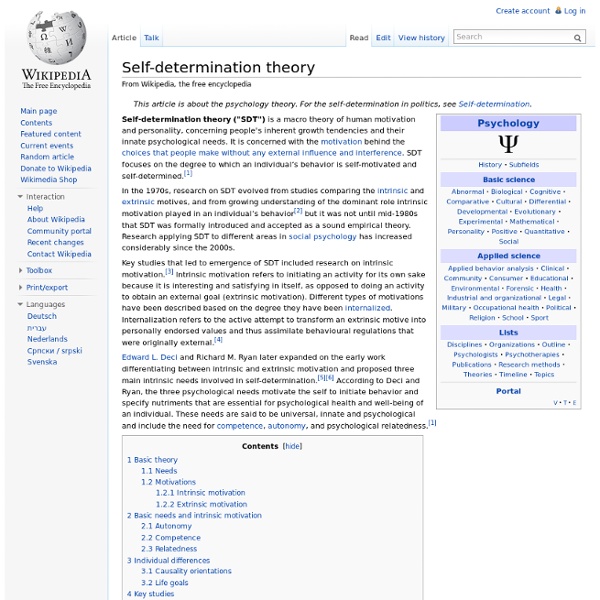Humanistic psychology
Humanistic psychology is a psychological perspective which rose to prominence in the mid-20th century in response to the limitations of Sigmund Freud's psychoanalytic theory and B.F. Skinner's behaviorism.[1] With its roots running from Socrates through the Renaissance, this approach emphasizes individuals inherent drive towards self-actualization and creativity. It typically holds that people are inherently good. In the 20th century humanistic psychology was referred to as the "third force" in psychology, distinct from earlier, even less humanistic approaches of psychoanalysis and behaviorism. Its principal professional organizations in the U.S. are the Association for Humanistic Psychology and the Society for Humanistic Psychology (Division 32 of the American Psychological Association). Origins[edit] One of humanistic psychology's early sources was the work of Carl Rogers, who was strongly influenced by Otto Rank, who broke with Freud in the mid-1920s. Conceptual origins[edit]
Sports Medicine Research: In the Lab & In the Field: Nothing to Fear but Fear Itself: Psychological Factors Related to Return to Sport Post-injury (Sports Med Res)
A Systematic Review of the Psychological Factors Associated with Returning to Sport Following Injury Ardern C, Taylor N, Feller J, Webster K. Br J Sport Med 2012; 0: 1-8 An often overlooked aspect of a clinician’s responsibility is to manage and mitigate an athlete’s psychological response to injury throughout the rehabilitation process, which is often associated with tension, low self-esteem, depression, and anxiety. Self-determination theory has been applied to identify factors that may influence an athlete’s psychological response, particularly emphasizing the basic needs of autonomy (motivation), competence (fear and confidence), and relatedness (social belonging). While not always addressed, these results suggest that it is imperative for clinicians to consider the psychological response of athletes not just post-injury, but in anticipation of return to sport as well. Written By: Laura McDonald Reviewed by: Jeffrey Driban Related Posts:
Original Position
1. Historical Background: the Moral Point of View The idea of a moral point of view can be traced back to David Hume's account of the “judicious spectator.” Hume sought to explain how moral judgments of approval and disapproval are possible given that people normally are focused on achieving their particular interests. He conjectured that in making moral judgments individuals abstract in imagination from their own particular interests and adopt an impartial point of view from which they assess the effects of others' actions on the interests of everyone. Since, according to Hume, we all can adopt this impartial perspective in imagination, it accounts for our agreement in moral judgments. Subsequently, philosophers posited similar perspectives for moral reasoning designed to yield impartial judgments once individuals abstract from their particular aims and interests and assess situations from an impartial point of view. 2. How is this social contract to be conceived? 3.
Logotherapy
Basic principles[edit] The notion of Logotherapy was created with the Greek word logos ("meaning"). Frankl’s concept is based on the premise that the primary motivational force of an individual is to find a meaning in life. The following list of tenets represents basic principles of logotherapy: Life has meaning under all circumstances, even the most miserable ones.Our main motivation for living is our will to find meaning in life.We have freedom to find meaning in what we do, and what we experience, or at least in the stand we take when faced with a situation of unchangeable suffering.[4] The human spirit is referred to in several of the assumptions of logotherapy, but the use of the term spirit is not "spiritual" or "religious". Discovering meaning[edit] "Once, an elderly general practitioner consulted me because of his severe depression. Philosophical basis of logotherapy[edit] Logotherapeutic views and treatment[edit] Overcoming anxiety[edit] Treatment of neurosis[edit] Depression[edit]
Anterior cruciate ligament- specialized post-operative return-to-sports (ACL-SPORTS) training: a randomized control trial
Aristotle: Nichomachean Ethics
Book 5, Chapter 1 WITH regards to justice and injustice we must (1) consider what kind of actions they are concerned with, (2) what sort of mean justice is, and (3) between what extremes the just act is intermediate. Our investigation shall follow the same course as the preceding discussions. We see that all men mean by justice that kind of state of character which makes people disposed to do what is just and makes them act justly and wish for what is just; and similarly by injustice that state which makes them act unjustly and wish for what is unjust. Let us too, then, lay this down as a general basis. Now often one contrary state is recognized from its contrary, and often states are recognized from the subjects that exhibit them; for (A) if good condition is known, bad condition also becomes known, and (B) good condition is known from the things that are in good condition, and they from it. Book 5, Chapter 2 Book 5, Chapter 3 This, then, is one species of the just. Book 5, Chapter 4
Science of what happens when we die
Home»Human Consciousness Project The Human Consciousness Project is an international consortium of multidisciplinary scientists and physicians who have joined forces to research the nature of consciousness and its relationship with the brain, as well as the neuronal processes that mediate and correspond to different facets of consciousness. The Human Consciousness ProjectSM will conduct the world’s first large-scale scientific study of what happens when we die and the relationship between mind and brain during clinical death. The mystery of what happens when we die and the nature of the human mind has fascinated humankind from antiquity to the present day. Since the 1950s and 60s, marked improvements in resuscitation techniques have led to higher survival rates for patients experiencing cardiac arrest. Contrary to popular perception, death is not a specific moment, but a well-defined process.
Muscle strength and hop ... [Knee Surg Sports Traumatol Arthrosc. 2011



